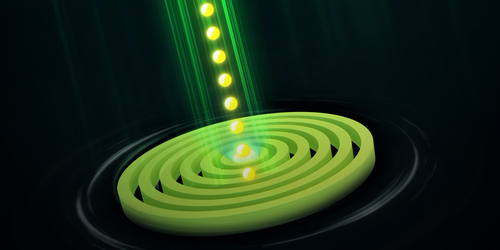Researchers Get Closer to Perfect Single-photon Source
The research team led by Prof. PAN Jianwei and Prof. LU Chaoyang from University of Science and Technology of China (USTC) of the Chinese Academy of Sciences (CAS) and international collaborators observed intensity squeezing on a single-photon source combining high levels of efficiency, purity and indistinguishability. This study was published in Physical Review Letters.
Single-photon source is an important tool in quantum metrology, and a challenging topic is to suppress its intrinsic fluctuations at quantum scale.
Intensity squeezing allows experimental scientists to adjust the relative size of a pair of conjugate quantities, such as position and momentum, time and energy, under the constraints of Heisenberg’s uncertainty principles, reducing the uncertainty of the targeted physical quantities.
It was theoretically predicted to be observable in resonance fluorescence from a two-level quantum system by Mandel. However, a great photon loss in the process of generating, collecting and detecting resonance fluorescence, decreasing the efficiency, hindered the experimental observation.
The researchers has dedicated to developing high-quality single-photon sources. They constructed a single-mode fiber-coupled highly indistinguishable solid-state single-photon source by coupling a semiconductor quantum dot to the center of a 2-μm-diameter cavity using tiny micropillars.
When excited by a pulsed laser, the quantum dot emitted single photons, which were tightly confined in the cavity. This confinement helped reduce photon loss when the photons were subsequently funneled into an optical fiber and measured with a semiconducting nanowire detector.
With the system, the researchers demonstrated a ~ 13% reduction of intensity fluctuation compared to the shot-noise limit, which is associated with an unconfined source, and the intensity squeezing at the output was 0.59 dB. By taking into consideration all the photon loss in the whole optical path, from the quantum source to the detector, the squeezing at the first lens was estimated to be 3.29 dB. This reduction translated into a more precise measurement of the average photon rate-17.5 photons per 1.0 μs, with a standard deviation of 3.65 photons.
This study filled a long-sought-after missing element in textbook quantum optical phenomena using quantum dots. Meanwhile, the device can be used as a new standard for optical radiation and in scalable quantum metrology with indistinguishable single photons, for example, reformulating the SI unit of light intensity in terms of photon number.

Semiconductor quantum dot emits photons that are squeezed below the fundamental noise limit (Image by LU Chaoyang)
Back
